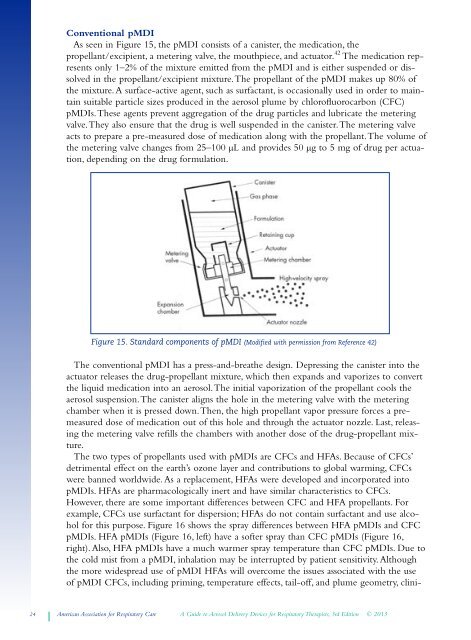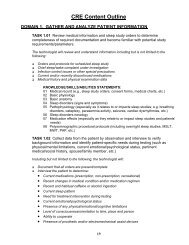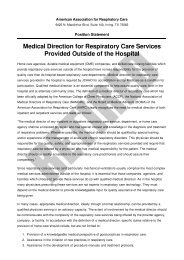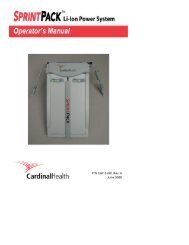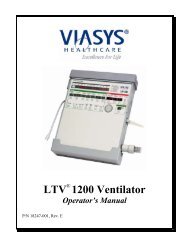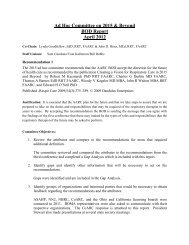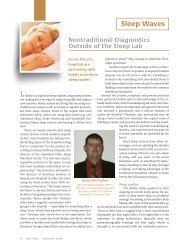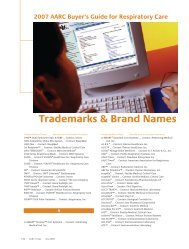Aerosol Guide - AARC.org
Aerosol Guide - AARC.org
Aerosol Guide - AARC.org
You also want an ePaper? Increase the reach of your titles
YUMPU automatically turns print PDFs into web optimized ePapers that Google loves.
Conventional pMDI<br />
As seen in Figure 15, the pMDI consists of a canister, the medication, the<br />
propellant/excipient, a metering valve, the mouthpiece, and actuator. 42 The medication represents<br />
only 1–2% of the mixture emitted from the pMDI and is either suspended or dissolved<br />
in the propellant/excipient mixture. The propellant of the pMDI makes up 80% of<br />
the mixture. A surface-active agent, such as surfactant, is occasionally used in order to maintain<br />
suitable particle sizes produced in the aerosol plume by chlorofluorocarbon (CFC)<br />
pMDIs. These agents prevent aggregation of the drug particles and lubricate the metering<br />
valve. They also ensure that the drug is well suspended in the canister. The metering valve<br />
acts to prepare a pre-measured dose of medication along with the propellant. The volume of<br />
the metering valve changes from 25–100 µL and provides 50 µg to 5 mg of drug per actuation,<br />
depending on the drug formulation.<br />
Figure 15. Standard components of pMDI (Modified with permission from Reference 42)<br />
The conventional pMDI has a press-and-breathe design. Depressing the canister into the<br />
actuator releases the drug-propellant mixture, which then expands and vaporizes to convert<br />
the liquid medication into an aerosol. The initial vaporization of the propellant cools the<br />
aerosol suspension. The canister aligns the hole in the metering valve with the metering<br />
chamber when it is pressed down. Then, the high propellant vapor pressure forces a premeasured<br />
dose of medication out of this hole and through the actuator nozzle. Last, releasing<br />
the metering valve refills the chambers with another dose of the drug-propellant mixture.<br />
The two types of propellants used with pMDIs are CFCs and HFAs. Because of CFCs’<br />
detrimental effect on the earth’s ozone layer and contributions to global warming, CFCs<br />
were banned worldwide. As a replacement, HFAs were developed and incorporated into<br />
pMDIs. HFAs are pharmacologically inert and have similar characteristics to CFCs.<br />
However, there are some important differences between CFC and HFA propellants. For<br />
example, CFCs use surfactant for dispersion; HFAs do not contain surfactant and use alcohol<br />
for this purpose. Figure 16 shows the spray differences between HFA pMDIs and CFC<br />
pMDIs. HFA pMDIs (Figure 16, left) have a softer spray than CFC pMDIs (Figure 16,<br />
right). Also, HFA pMDIs have a much warmer spray temperature than CFC pMDIs. Due to<br />
the cold mist from a pMDI, inhalation may be interrupted by patient sensitivity. Although<br />
the more widespread use of pMDI HFAs will overcome the issues associated with the use<br />
of pMDI CFCs, including priming, temperature effects, tail-off, and plume geometry, clini-<br />
24 American Association for Respiratory Care A <strong>Guide</strong> to <strong>Aerosol</strong> Delivery Devices for Respiratory Therapists, 3rd Edition © 2013


